Robots Take the Heat
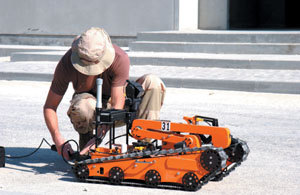 |
| A U.S. Navy technician with Explosive Ordnance Disposal Mobile Unit 4 (EODMU-4) Detachment 10 prepares a robot to take part in an improvised explosive device (IED) training exercise. Robots are being used in current operations to disable or detonate IEDs from a safe distance. Explosive ordnance disposal (EOD) team training includes how to address the challenges being faced in Iraq and Afghanistan. |
Remote control devices save hundreds of lives.
Combatants in the war on terrorism come in all shapes and sizes, including some that are nuts and bolts, metal and machinery. In operations in both Afghanistan and Iraq, warfighters count not only on their buddies to keep them safe but also on luggage-size robots that help clear the improvised explosive devices being used so incessantly by insurgents. Using manportable mechanical marvels, explosive ordnance disposal teams can disarm or detonate explosives from a distance, keeping team members out of harm’s way while clearing the way for troop movement.
In what has been called a “truly successful joint program,” explosive ordnance disposal (EOD) teams from each service have been using a set of robots—each armed with cameras, sensors and a claw—since operations began in Afghanistan to ensure the safety of warfighters. According to Master Sgt. Ted Bogosh, USMC, manager, joint robotics repair facility, Redstone Arsenal, Alabama, robots allow the teams to disarm or detonate improvised explosive devices (IEDs) from as far away as several hundred yards. The latest generation of robots features improved dexterity and has longer lasting power supplies than the robots available in the 1990s, he says.
In current operations, the largest robot weighs less than 250 pounds—or about as much as a person—the smallest, about 50 pounds. Each EOD team is equipped with two manportable, man-packable robots: the primary plus a spare. Military units also carry extra robots so demolished devices can be replaced.
In addition to the robot, the team has a groundstation that is approximately the size of a laptop computer and carried in a briefcase. On the computer screen, team members can view video captured by cameras mounted on the robot as well as can monitor the status of the robot’s mechanisms. The groundstation also includes a joystick, knob or computer panel that operators use to move and direct the robot.
One or several EOD teams deploy to disable or detonate an IED depending on the situation; however, one team member generally takes charge of the robot during the mission. The team’s goal is always to make an area safe, but the circumstances determine how this is accomplished. “The team may use the robot as a kamikaze robot that goes up to the IED and blows up, taking the IED with it. Every robot we have is expendable. We try to bring it back, but our primary goal is the safety of our people,” the master sergeant says.
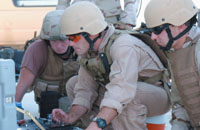 |
| Members of EODMU-4 Detachment 10 control a robot during the unit’s final evaluation phase of IED disposal training. The groundstation for the robots includes a computer screen to view video captured by cameras mounted on the robot, status information about the robot’s mechanisms and a joystick, knob or computer panel for directing the robot. |
The exact procedure for disarming a device depends on the type of IED. Although some of the robots can perform some actions autonomously, all require an operator, the master sergeant says. “Some robots are more autonomous than others, but we don’t want to explain how autonomous because unfortunately some of the bad guys are extremely educated and read this stuff,” he shares.
But the master sergeant does point out that the robots used in operations today are a considerable improvement over those available only a few years ago. In the late 1990s, a very limited selection of robots existed. Some of these were used early in operations in Afghanistan for de-mining missions.
Although he cannot disclose details about the improvements in the latest generation of robots, the master sergeant reveals that the most progress has occurred in battery technology. Prior to 2000, robots sometimes ran out of power before completing a mission.
The master sergeant also shares that adding an arm and claw has increased the robots’ usefulness significantly. “Most robots in the past didn’t even have a claw. They could go up and look at something, but they couldn’t do much. Some could carry a package and drop it off or blow it up. Currently, they have a claw, and with it the operators can undo latches or open car doors. Some can even untie bootlaces. The capability depends on the robot. And the next-generation robot will be even more incredible,” he says.
Although Master Sgt. Bogosh says that EOD teams can operate the robots from far enough away to detonate an IED safely, the maximum span between operators and robots cannot be revealed. “One of the lessons we learned in country is that when the enemy sees you stopping at a given distance from an IED, they start putting a second IED that distance away from the first one,” the master sergeant relates. He is able to disclose that the EOD team can control a robot from “football fields away.”
From a mobility standpoint, today’s robots, which are tracked vehicles, are able to travel around and over boulders. Depending on the terrain, the robots’ speed ranges from a slow crawl to fast enough to catch up with a running person.
The robots have been doing an excellent job of preventing EOD team casualties, although calculating the exact number is difficult, Master Sgt. Bogosh admits. “Several of the robots were blown up really bad. If a person were standing there, the IED would have blown him to pieces. Well over 100 people are alive today because robots could be used. Every day, we’re getting robots that are blown up in some manner. Sometimes, it’s something minor; sometimes they are actually dismantled. The explosion and the shrapnel may have disabled the robot, but they would have killed a person,” the master sergeant says.
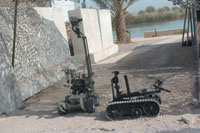 |
| The Mini-Androse (l) and Talon robots are equipped with cameras, sensors and claws that EOD teams can operate from a distance of several hundred yards. |
Today’s robots were developed in the warfighting laboratories of the services and manufactured by companies that are providing them to the military as quickly as they produce them. They were not built specifically for the missions in Iraq and Afghanistan, Master Sgt. Bogosh says, but the troops have been providing the companies with feedback about robot performance. Every time a damaged robot returns from a mission, the maintenance crew determines how it was damaged as well as how the robot design could be improved so it that cannot be damaged in the same way again or it is easier to repair, he adds.
“The companies can capitalize on the robots’ strong points and improve the weak points. And, if a mission can’t be accomplished, we’re telling them what it is and what the robots need to be able to do to accomplish the mission. Some of the vendors are taking great advantage of this information; some have made modifications and experimental prototypes that they can field. But at this point, there aren’t any real changes. We’re using what we have, and it’s going well so far,” he states.
Each EOD team is trained in basic robot maintenance and repair, but when the damage is severe, specialized repair teams in the field handle major repairs. “Repairs of all the robots are done in theater so we don’t have to send them back to the U.S. This saves a considerable amount of time and keeps the robots functioning. On a regular basis, the repair teams take a robot that has been blown up by an IED, repair it and put it right back into service,” Master Sgt. Bogosh explains.
Approximately half of the repair technicians are U.S. Navy reservists, and the other half is a combination of U.S. Army logistics assistance representatives and civilian ManTech International Corporation employees. The teams perform repairs for both U.S. EOD teams and an Iraqi EOD team.
Although the robots being used in operations today are performing well, Col. Edward M. Ward, USMC, logistics chief of the Robotic Systems Joint Project Office at Redstone Arsenal, shares that his office is examining another approach to create the next generation of robots. “We’re in the process of coordinating and implementing spiral development. This is being done in various phases to be sure we don’t get too far ahead of the pointy end of the spear but yet identify requirements and respond to the warfighter as quickly and efficiently as possible. We will take various derivatives of another generation of robots and evaluate them, redefining the requirements because what we think are the requirements here and what they are over there may not necessarily be synonymous,” Col. Ward says.
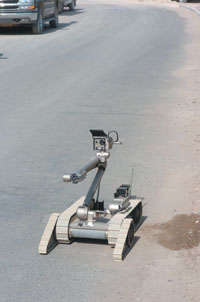 |
| The Packbot features triangular tracks in the front of the vehicle that help it travel over rough terrain. |
The joint project office is in the first stages of acquiring a new generation of robot that will address the issues of harsh environments. “The next generation is beginning, and it’s exciting,” he states. Master Sgt. Bogosh agrees. “These are definitely cutting-edge. To think, you could have a robot that could actually outrun a human is definitely amazing,” he asserts.
Col. Ward predicts that future robots will carry out more than just EOD missions—from reconnaissance to crowd control. “The only thing that limits the uses is the imagination,” he states.
To attain this level of capabilities, industry can continue working to improve power supplies as well as the human-robot interface, the colonel says. “The better the interfaces, the better the robots can be. A helmet display or the ability to use hand movements to control the robots or voice-activated robots are all possibilities,” he offers.
Col. Ward and Master Sgt. Bogosh concur that, although the robots do extraordinary work, the operators are at the heart of the program’s success. “Every day is a chess match. The enemy comes up with new ideas of how to defeat the robots; we come up with new countermeasures. The EOD teams are some of the sharpest people I know. It’s a very lethal match,” the master sergeant says.
Web Resources
U.S. Navy Explosive Ordnance Disposal: www.eod.navy.mil
U.S. Army Ordnance Corps: www.goordnance.apg.army.mil
U.S. Defense Department Explosive Ordnance Technology Program: https://naveodtechdiv.navsea.navy.mil/DoDEodTechPgm/Default.asp


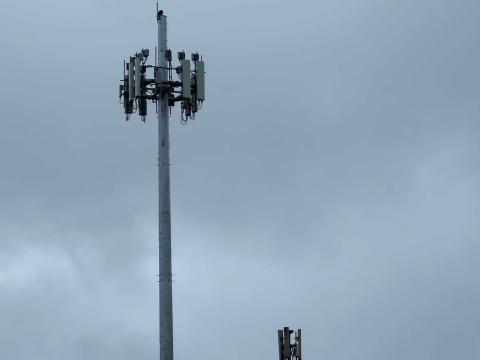
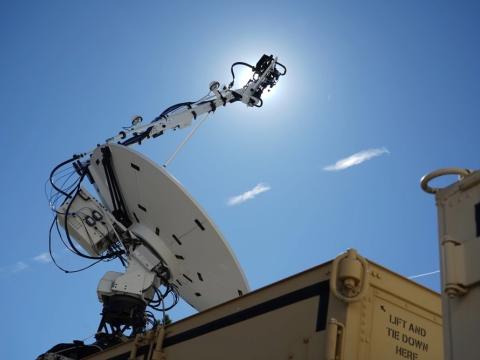
Comments